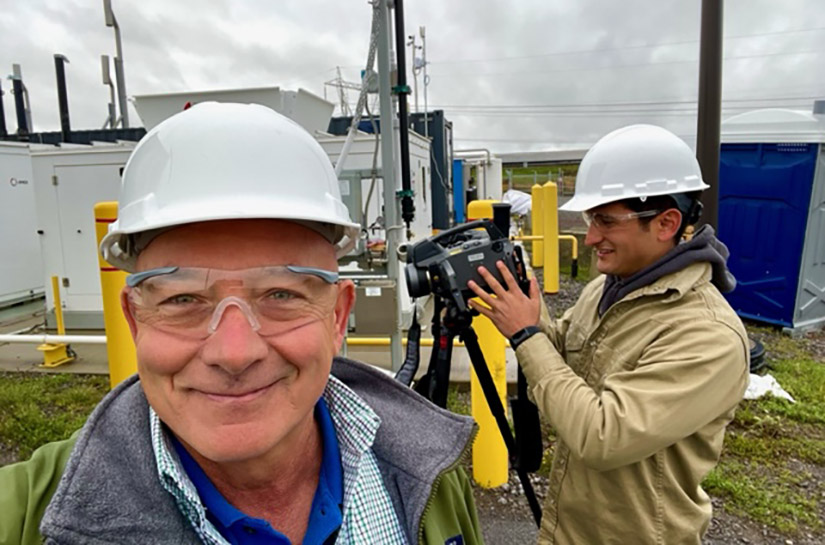Chevron Studio Program Aims Tech To Go From Lab to Market
In creating the Chevron Studio program, the National Renewable Energy Laboratory (NREL) and Chevron Technologies Venture (CTV) teamed up to turn a challenge into an opportunity.
“We have a long working relationship with several national laboratories and universities,” said Gautam Phanse, strategic relationship manager for CTV. “While there has been a lot of science coming out of these labs, the challenge has been scaling and commercializing. This program aims to close that gap. CTV also has a lot of experience in working with the innovation ecosystem supporting entrepreneurs, incubators, and startups. So, we asked ourselves: How can we structure a program so it becomes a win-win for all the stakeholders—the laboratories where the science is developed, entrepreneurs who can move these nascent technologies forward, and industry partners to scale. The answer is Chevron Studio.”

Chevron Studio, managed by NREL’s Innovation and Entrepreneurship Center (IEC), invites entrepreneurs to scale up an intellectual property (IP) that comes from a national laboratory or university by supporting them through the various stages of scale-up. Launched in 2022, the program comprises three phases that aim to accelerate the technology to the market: Discovery, Scale-Up, and Field Trial.
“There are very few programs that encompass the whole breadth of the innovation cycle,” Phanse said. “We wanted to take it beyond the traditional incubator and accelerator stage. The Chevron Studio program supports companies right from the lab all the way to the market.”
CTV came to NREL because of the laboratory’s strength in scaling up technologies. Chevron Studio comes in a long line of successful startup and technology assistance programs out of the IEC including the Wells Fargo Innovation Incubator (IN2), the Shell GameChanger Accelerator™ Powered by NREL (GCxN), Energy I-Corps, West Gate, and more.
“We felt NREL could really amplify this idea and take it to the next level,” Phanse said.
The first of Chevron Studio’s three phases is called the Discovery phase. The program matches entrepreneurs with a technology of interest at a national laboratory or university. The entrepreneurs then work with the inventor to evaluate the IP and develop a business plan. Their goal is to understand both the technology and its market potential, then determine what it will take to scale the technology. The process lasts about three months, and at the end of the phase, a steering committee made up of experts from both CTV and NREL selects which entrepreneurs will move forward based on their business plan.
“When Chevron Studio selects an entrepreneur, they come into the program as an individual. During the first phase, they analyze the IP and determine how a company can be built around it,” Chevron Studio Program Manager Steven Yackel said. “In phase two, they start to scale up and create a company around the technology.”
Phase two, the Scale-Up phase, lasts up to 24 months as the entrepreneur hones skills by evaluating and de-risking cutting-edge technologies and developing business acumen. At the end of the phase, the company is expected to develop a scaled-up prototype to demonstrate the value and business proposition of the technology. The entrepreneur presents their technical findings, business plan, and growth potential again, and they are evaluated before moving on to the last phase.
Phase three is the Field Trial phase, where the company designs and operates a minimum commercial-size technology at an industrial site.
Chevron Studio supports startups throughout the three phases via seed funding, networking, and technical assistance. It is now on its third cohort, with each entrepreneur moving through a custom timeline for their IP. In total, 11 entrepreneurs participated in the Discovery phase, with three entrepreneurs graduating to the Scale-Up phase and forming companies.
One entrepreneur-investor team has made it to the Field Trial phase where they will implement and test the technology in a real-world environment.
“We are pioneering a unique category of software to make rapid, accurate detection of methane easy for hundreds of billions of components worldwide with optical gas imaging,” said Babur Ozden, founder of Aquanta, the first company to reach phase three. “Methane is not visible in normal visual spectrums—it can only be detected with special equipment and software.”

Aquanta’s product, NetxteN, a software app, can be installed on a smartphone, tablet, or laptop and automate detection. That can make it more convenient for those trying to detect methane leaks and find leak sources in the field, potentially improving methane detection. Today, detection requires human intervention and interpretation, which means 60% of the leaks go undetected and one-third of detections are unreliable.
“Once methane is leaked, you cannot remove it from the atmosphere. There’s no catching it. We must keep methane in the pipe,” Ozden said. “Our technology aims to empower a worldwide optical gas imaging ecosystem of hardware and services that is more effective and efficient in detecting methane.”
The innovation at the core of Aquanta’s technology was invented at Colorado State University in Fort Collins, Colorado, by Marcus Martinez.
“At the end of the Chevron Studio program, we expect our product to be commercially available in the market,” Ozden said. “I always like being first because there’s a learning curve, which becomes one’s competitive advantage. You start with several assumptions, then you test them out with your early champions and discover things collectively.”
While CTV does support the participants in Chevron Studio with some funding, the companies are expected to raise additional funds outside of the program, just like any startup.
“Chevron is in this for the long haul,” Phanse said. “We want to make sure you can withstand the rigors of the startup process. We will help you cross that 'valley of death,' not by giving you a blank check but working with you and supporting you through this journey.”
Learn more about the Chevron Studio program.
Last Updated May 28, 2025
